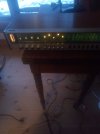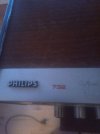-
Welcome to ASR. There are many reviews of audio hardware and expert members to help answer your questions. Click here to have your audio equipment measured for free!
- Forums
- Audio, Audio, Audio!
- Amplifiers, Phono preamp, and Analog Audio Review
- Stereo and Multichannel Amplifier Reviews
You are using an out of date browser. It may not display this or other websites correctly.
You should upgrade or use an alternative browser.
You should upgrade or use an alternative browser.
Topping PA5 Review (Amplifier)
- Thread starter amirm
- Start date
How about reversing the tweeter's polarity relative to the woofer. It definitely has an audible effect (worst case phase shift on high frequencies).Direct sound arrives first and due to precedence effect, has strong power in establishing the tonality of the speaker. So no, you can't turn the speaker around and expect it to sound the same. You would be hearing the rear radiating on-axis sound which is mostly low to mid frequencies.
Severe mid/ high dip in FR.How about reversing the tweeter's polarity relative to the woofer. It definitely has an audible effect (worst case phase shift on high frequencies).
Then it is a question of absolute phase difference and not relative, as I understand what Amir talked about in his video.How about reversing the tweeter's polarity relative to the woofer. It definitely has an audible effect (worst case phase shift on high frequencies).
Note, I think.I could be wrong.
- Joined
- Dec 15, 2019
- Messages
- 559
- Likes
- 989
Regrading how much ampl. power I need for the dynamics let me admit that I often sit with the remote in my hand to turn down the volume in the loud passages. I sometimes like great dynamics but most of the time I like lessor dynamics to be honest. I know some sections of music are meant to shake the barn but I don't most of the time want my living room so shaken so I briefly turn down the volume. Am I the only one. I find it surprising that so many of you out there in internet land like your music at 80, or 85, or 90 or decibels. I'm a wienie I guess.Many questions about whether the effect is sufficient in PA5. How much effect can be needed when playing music with a lot of dynamics? Here this video maybe can give some guidance:
No wonder there is usually talk of a headroom when it comes to power and amplifiers.Although it is clear if you play music that is very compressed, no peaks or valleys but more of a smooth porridge, it does not place such high demands on the amplifier. Which, incidentally, is mentioned in that video.

Does A More Powerful Amplifier Make Speakers Sound Better?
Does A More Powerful Amplifier Make Speakers Sound Better?audiosciencereview.com
Last edited:
No. You're suffering from some form of sibilance that makes it tough on your ears to listen for longer periods on loud vol. Try better gear or upsampling to high DSD levels.I'm a wienie I guess.
Everyone can listen in any way they want, of course. If you get tired of listening to dynamic music, at a fairly high volume well I do not know if I should mention it. You may have a really good system, but distortion (clipping) can be quite irritating to the ears.Regrading how much ampl. power I need for the dynamics let me admit that I often sit with the remote in my had to turn down the volume in the loud passages. I sometimes like great dynamics but most of the time I like lessor dynamics to be honest. I know some sections of music are meant to shake the barn but I don't most of the time want my living room so shaken. I briefly turn down the volume Am I the only one. I find it surprising that so many of you out there in internet land like your music at 80, or 85, or 90 or decibels. I'm a wienie I guess.
As an example, the receiver you see in the pictures I bought this weekend at a flea market for a few dollars. It works but damn what a pain in the ears I get when I listen to it. I will immediately return it to some charity flea market. Whoever then buys it does a good deed. For others, that is, not for his own ears, on the contrary in that case.
Tips test really bad Hifi so you realize what decent Hifi can do.
Edit:
Regarding Philipsen. It is possible that it would sound better if it was serviced, capacitors were replaced and so on. Nothing I intend to do with it. I sprayed pots with electronics spray and motinated them but more than that I do not do with it.
(no imagination, if I could not dot that Philips in a blind test I would eat my hat)
Attachments
Last edited:
What if the amp in question has a significant phase shift in the high frequencies, can it affect some speakers with complex crossovers that will lead to frequency response difference?Severe mid/ high dip in FR.
Significant phase shift means quite big deviation in amplifier amplitude response. So it will be audible change in “amplifier sound”. As amplifier phase response will be most probably smooth near speaker crossover frequency, the speaker will not be “affected”.What if the amp in question has a significant phase shift in the high frequencies, can it affect some speakers with complex crossovers that will lead to frequency response difference?
- Thread Starter
- #1,911
That screws up the crossover frequency response.How about reversing the tweeter's polarity relative to the woofer. It definitely has an audible effect (worst case phase shift on high frequencies).
KSTR
Major Contributor
Reversing tweeter polarity effect depends on crossover type. In a crossover with close to 90 degrees phase offset between drivers (symmetric odd order acoustic XOs, often seen in W-T-W arrangements), the frequency response remains effectively unchanged but the phase response is changed. Typically not very audible as the XO freq is high (both channels flipped, of course). In a woofer-to-midrange XO it's audible sometimes.
But this is all excess phase stuff (allpass function), not minimum phase as for amplifiers.
But this is all excess phase stuff (allpass function), not minimum phase as for amplifiers.
Do some amplifiers have worse phase response relative to their amplitude response or are the amps mostly have the same deviation from FR and phase response? (disregarding all pass filtering) How much deviation is there in phase response that would cause spatial or audible difference in the speakers?Significant phase shift means quite big deviation in amplifier amplitude response. So it will be audible change in “amplifier sound”. As amplifier phase response will be most probably smooth near speaker crossover frequency, the speaker will not be “affected”.
So if FR is unchanged, then there would be no audible difference in phase response in the HF? I just want to learn here.
Do some amplifiers have worse phase response relative to their amplitude response or are the amps mostly have the same deviation from FR and phase response? (disregarding all pass filtering) How much deviation is there in phase response that would cause spatial or audible difference in the speakers?
So if FR is unchanged, then there would be no audible difference in phase response in the HF? I just want to learn here.
Please take into account that it depends on load complex impedance and amplifier circuit topology. Please let me answer you by measurements of amplitude frequency response and phase frequency response of a conventional class AB amplifier vs. TPA3255 AIYIMA A07 - and think about it. If more discussion is needed, a separate thread would be an option, I can paste my measurements there. Is this audible in a DBT test? Yes, not easily, but with better than 5% uncertainty. Is this because of phase response? Just related to, as a derived parameter. Can we read this from 4/8 ohm resistive response? With difficulties.
P.S.: new plots with soundcard FR elimination
Last edited:
Probably not. It should be trivial to take some audio files and make two variants:I can paste my measurements there. Is this audible in a DBT test? Yes, not easily, but with better than 5% uncertainty. Is this because of phase response?
- A: only reproduce the amplitude response you measured.
- B: only reproduce the phase response you measured.
Definitely yes. The test was already posted, half a year or more ago. Please try to find it, with the ASR search engine. The result was positive, with audible difference proven.Probably not. It should be trivial to take some audio files and make two variants:
Then ABX those two against the original. I'm pretty sure A will be possible, B will not.
- A: only reproduce the amplitude response you measured.
- B: only reproduce the phase response you measured.
P.S.: amplitude and phase response cannot be separated, it would be a nonsense. They are related through Hilbert transform, as I already explained ( yesterday).
Yes, you tested A + B together, not these factors separately as far as I know. The question is: which one of the two is audible in this case: phase or amplitude. Or did I totally miss that test?The test was already posted, half a year or more ago. Please try to find it, with the ASR search engine. The result was positive, with audible difference proven.
If you don’t think phase is audible flip polarity of one speaker for 180deg. That’s an extreme case I know but despite a room having reflections, the direct sound from the speaker is very important. Even on non bass heavy content music the “phasiness” is instantly detectable (it is in the 1kHz to 6kHz range). I can tell when speakers are accidentally flipped with ears instantly.
That is obviously different. First off, it's for all frequencies, not just HF. Secondly, the change is 180 deg, not the 30 to 40 deg at 20 kHz that we see in this example. Thirdly, you keep one speaker's phase in tact. Obviously, you'll get interference from that.If you don’t think phase is audible flip polarity of one speaker for 180deg. That’s an extreme case I know but despite a room having reflections, the direct sound from the speaker is very important. Even on non bass heavy content music the “phasiness” is instantly detectable (it is in the 1kHz to 6kHz range). I can tell when speakers are accidentally flipped with ears instantly.
Last edited:
How about reversing both speakers?If you don’t think phase is audible flip polarity of one speaker for 180deg. That’s an extreme case I know but despite a room having reflections, the direct sound from the speaker is very important. Even on non bass heavy content music the “phasiness” is instantly detectable (it is in the 1kHz to 6kHz range). I can tell when speakers are accidentally flipped with ears instantly.
Similar threads
- Replies
- 8
- Views
- 4K
- Replies
- 4
- Views
- 326
- Poll
- Replies
- 1K
- Views
- 187K
- Poll
- Replies
- 67
- Views
- 26K
- Replies
- 393
- Views
- 78K



